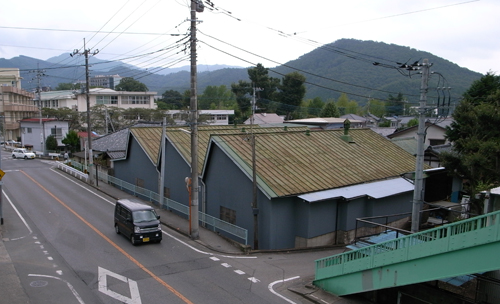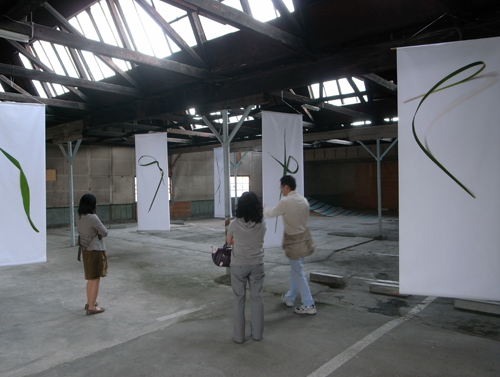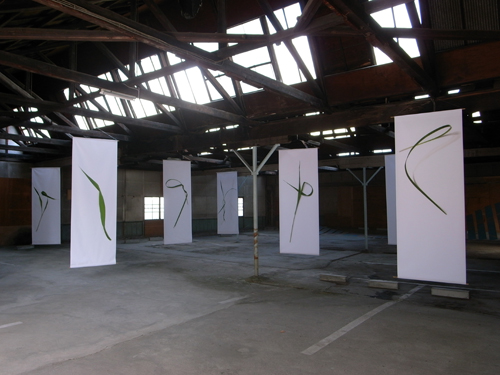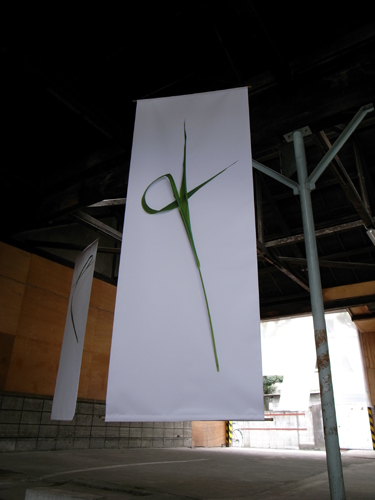The Tale of Seven Herbs:
Thoughts on Renewal in Kiryu, Japan
James Jack

Town planning and art don’t always make a good match. But in the town of Kiryu artists and local people have found innovative ways to work together over the past fifteen years through a project known as Kiryu Saien. Artists from Tokyo who wanted to move beyond white walls initiated a project that is reinvigorating a town where Main Street has just as many closed shutters as open ones. When I first made a visit to the former silk manufacturing town, I was astonished by the rustic buildings and struck by the lack of inhabitants at the same time. Observing the area and talking with people led me to think deeply about the role of renewal in the creative process. Is my art practice a process of making or remaking things in the world around me?
On my first trip I had very few expectations. On a bike ride around town I talked with elderly people playing ground golf for an hour and then soon grew sweaty so I took a break under the shade of a tree by the Kiryu River on the outskirts of the town. I sat for quite a while soaking up the landscape. This area of Gunma prefecture is not lucrative with tourist attractions or economic success, but I felt an enormous creative potential coming from the social landscape. I opened my sketchbook and set single blades of grass on a blank, white page. As I became absorbed in the creative experiment, an old man gently approached to ask what I was doing. When I told him how amazing the grass and landscape in his town were, his eyes lit up. He smiled and told me, “This is the best town on earth,” and then invited me to his house for tea. We proceeded to talk about his garden, his family, and the land. This was the first story that, in the end, became a series of cloth scrolls titled “Tale of Seven Herbs.” On that day I went back to Tokyo with a fragrant mint plant and a yearning to develop a new relationship with the people and site of Kiryu.
On a deeper investigation of Kiryu, I uncovered the historical significance of the town as a silk-producing center that garnered this reputation in the Edo period. It had been a wealthy town with prosperous families until kimonos were gradually replaced with suits and pants starting in the Meiji period, plunging Kiryu into a stunned uncertainty that it has not recovered from even today. Although most of the silk factories have been closed for three decades or longer, many of them look as if they shut down their operations just recently. In fact, the building where people engaged with my work was once one of these thriving silk factories. The photographic works I made for display in this space were printed on cloth to connect with the historical tradition of weaving in Kiryu. They hang freely from the roof beams; gently swaying with the movement of viewers and the air.
The year-round actions of artists participating in the Kiryu Saien project serve as a catalyst for reusing spaces in harmony with their historical nature. This model transforms “useless” spaces into creative zones of contact for exchange among people that wouldn’t normally interact. Despite the widespread absence of young people in the countryside, through this art project, young artists reconnect with local elders. Although cities are lucrative in many aspects, our urban lifestyles can often bring us out of touch with the land we are living on. This exhibit reminds us of the connection between our lives and the land we live on, reclaiming the spirit of place.




James Jack is currently a Crown Prince Akihito Scholar at Tokyo University of the Arts. His work has appeared in magazines such as Asian Art News, The Kyoto Journal, M: The New York Art World, and NY Arts. For more information about this artist, visit his website: www.jamesjack.org.

1 comment on “Installation: Jack”